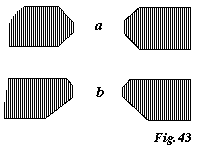CONSTRUCTION XVI. FORM OF APERTURE 213
as to turn aside as they enter or leave the door, and therefore touch its jamb, but, on the inside, will in almost every case approach the door or depart from it in the direct line of the entrance (people generally walking forward when they enter a hall, court, or chamber of any kind, and being forced to do so when they enter a passage), 
§ 6. If, however, beside frequent entrance, entrance is required for multitudes at the same time, the size of the aperture either must be increased, or other apertures must be introduced. It may, in some buildings, be optional with the architect whether he shall give many small doors, or few large ones; and in some, as theatres, amphitheatres, and other places where the crowd are apt to be impatient, many doors are by far the best arrangement of the two. Often, however, the purposes of the building, as when it is to be entered by processions, or where the crowd must usually enter in one direction, require the large single entrance; and (for here again the æsthetic and structural laws cannot be separated,) the expression and harmony of the building require, in nearly every case, an entrance of largeness proportioned to the multitude which is to meet within. Nothing is more unseemly than that a great multitude should find its way out and in, as ants and wasps do, through holes; and nothing more undignified than the paltry doors of many of our English cathedrals,1 which look as if they were made, not for
1 [Compare on this point Seven Lamps, ch. iii. § 24 (Vol. VIII. p. 136), where “the pitiful pigeon-holes which stand for doors in the west front of Salisbury” are likened to “the entrances to a beehive or wasp’s nest.”]
[Version 0.04: March 2008]